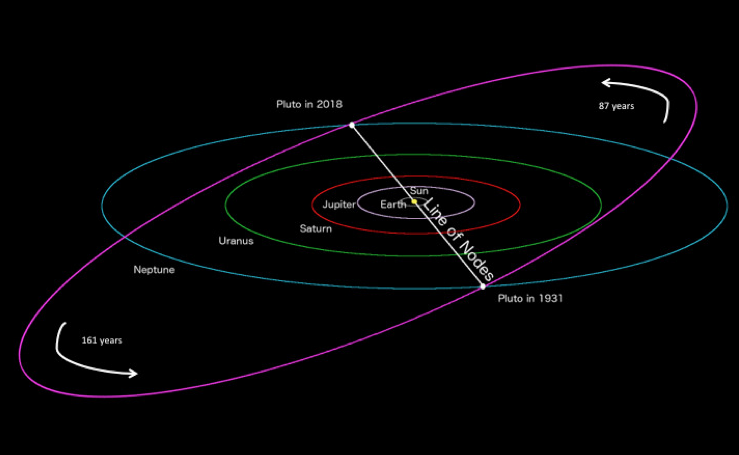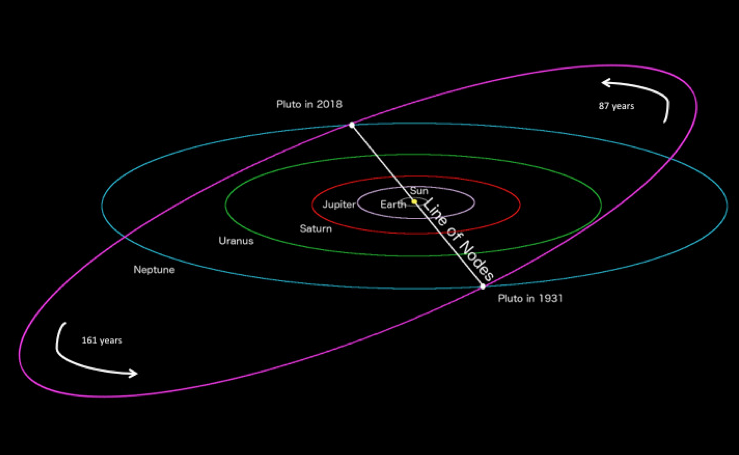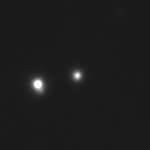
05 Sep Pluto: small, distant, and fascinating
Pluto is an interesting object located in the outer region of our Solar System. Although only 2376 km in diameter, it hosts five moons and a thin atmosphere. As shown in Figure 1, Pluto has a high orbital inclination (17 deg) and eccentricity (0.25), and it requires 248 years to travel once around the Sun. At 120 deg., Pluto has unusually high obliquity, which is the angle between the rotational pole and the orbital plane. Thus Pluto’s north pole (as defined by the right-hand rule) lies 40 deg. below the orbital plane. This combination of high orbital eccentricity and obliquity results in extreme seasons: Pluto’s most distant location from the Sun is nearly twice as far away as the closest, and each pole is exposed to the Sun for more than a century at a time. This geometry is expected to strongly affect the atmosphere.

Figure 1: Schematic plot of Pluto’s orbit in our Solar System. In 2018, Pluto crossed the ecliptic plane and is moving away from the Sun. Pluto was at perihelion in 1990 and won’t be there again for more than two hundred years. Credit: A. Verbiscer; earthsky.org
Pluto’s micro-bar atmosphere was first definitively detected in 1988. In 2002, measurements showed that the atmosphere had expanded, even though Pluto was moving away from the Sun. By 2015, when NASA’s New Horizons spacecraft [https://www.nasa.gov/mission_pages/newhorizons/main/index.html] flew through the Pluto system, the atmosphere was roughly the same size it had been in recent years. However, the story gets more intriguing: models of the mass and distribution of surface ice, which include thermal inertia, predict that Pluto’s atmosphere could collapse out completely. For these reasons, continued observations of Pluto are important.

Figure 2: Image from NASA’s New Horizons spacecraft of Pluto and Charon. This image was taken in July 2015, while the spacecraft was 5.4 million km from the bodies. The colours are approximately those that would be seen by the human eye: it is obvious that Pluto and Charon have very differently-coloured surfaces. Credit: NASA/JHU APL/SwRI.

Figure 3: Animated images of the Pluto system moving up to, and then past, the occultation star on 07 August 2017. Charon is clearly discernible from Pluto, with a separation of approximately 0.8 arcsec. These 60-sec images are subframes of an unfiltered dataset taken on NASA’s 3-m IRTF with MORIS. Discrete jumps occur between separate data cubes as well as during the occultation, when separate data were taken at significantly faster cadence. Credit: A. Sickafoose; N. Erasmus; SAAO
In August of 2017, researchers from the South African Astronomical Observatory (SAAO) and the Massachusetts Institute of Technology (MIT) observed a relatively rare event, a stellar occultation by the dwarf planet Pluto. The stellar occultation technique requires accurate measurements of the positions of a distant star and a foreground body, in order to predict exactly when and where on Earth a shadow will fall. In this case, Pluto was predicted to occult a star of approximately 15th visible magnitude, with the moderately-sized shadow path (less than 1/3 the diameter of Earth) falling over the northern Pacific Ocean. The event was observed remotely from Cape Town, using NASA’s 3-m IRTF (Infrared Telescope Facility [https://irtfweb.ifa.hawaii.edu/]) with the high-speed, accurately-timed, visible-wavelength instrument MORIS (MIT Optical Rapid Imaging System). Figure 3 contains Images taken before and after the occultation, which show Pluto and it’s largest satellite, Charon, as they approach the star and then after they pass by.
These data show that Pluto’s atmosphere still existed in late 2017. They are currently being analyzed, along with additional occultation measurements from 2018, to determine the most recent measurements of Pluto’s atmospheric characteristics. Results will be presented at the 2018 American Astronomical Society’s Division of Planetary Sciences meeting [https://aas.org/meetings/dps50] in October
